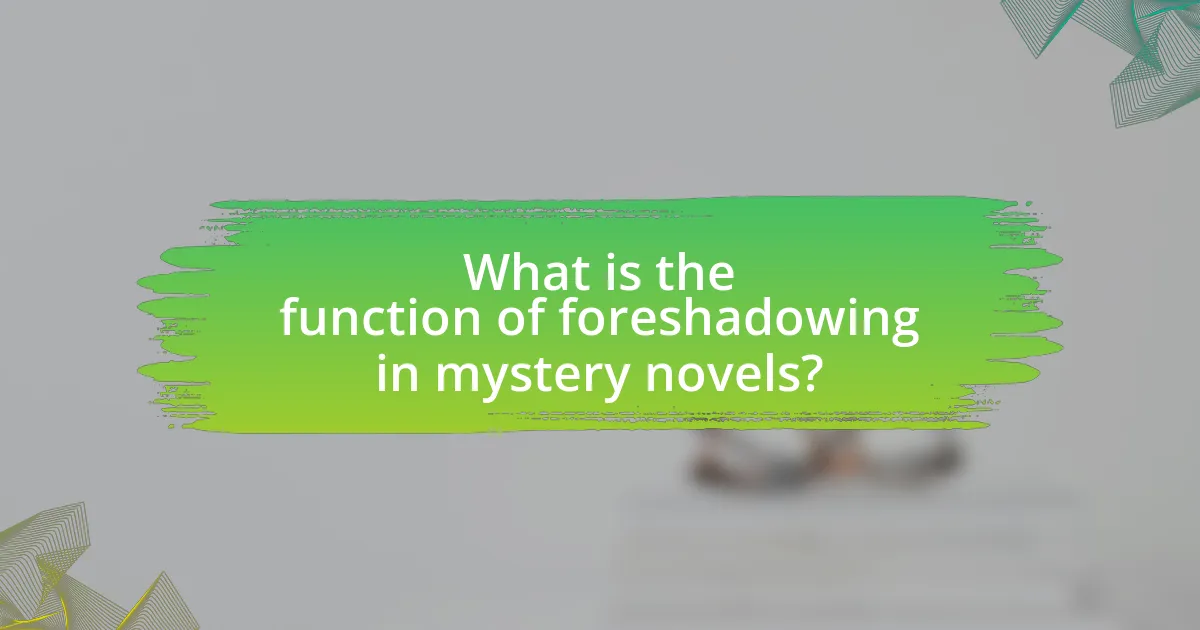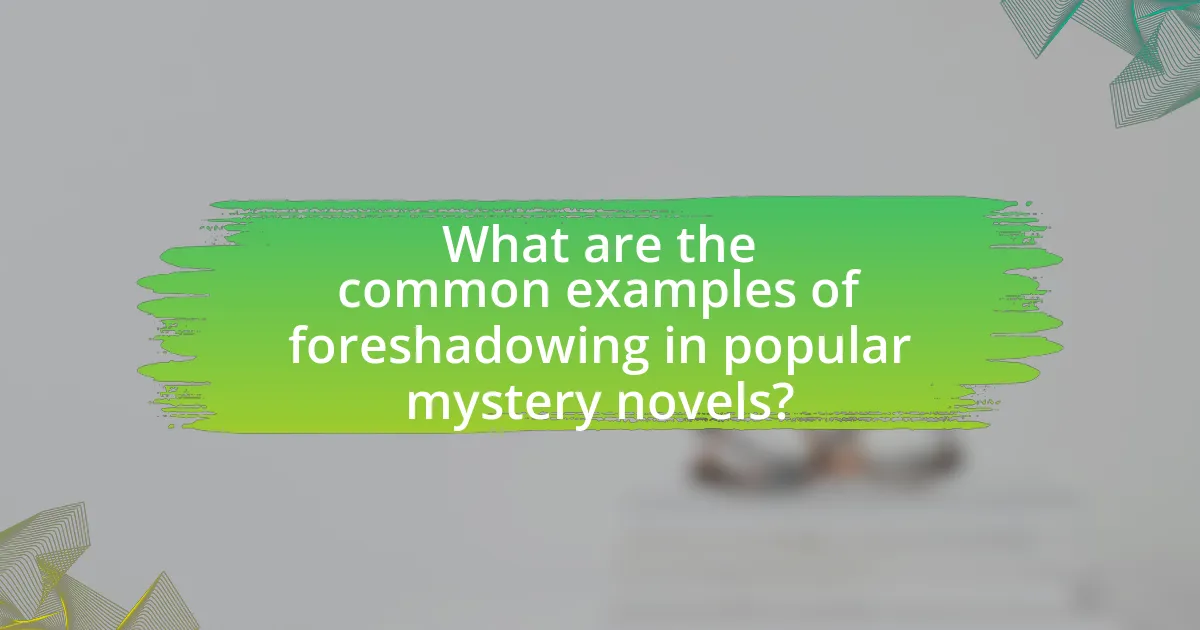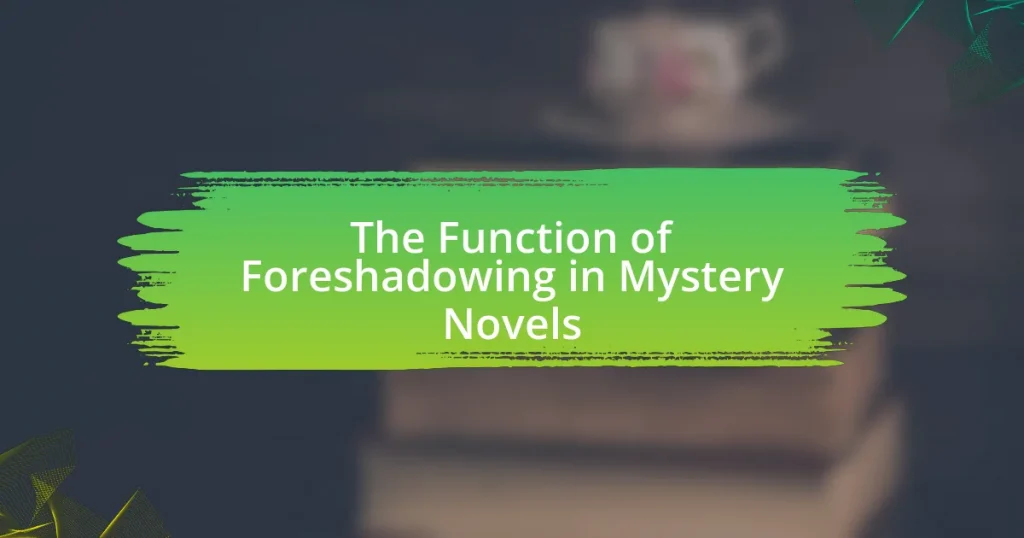The article examines the function of foreshadowing in mystery novels, highlighting its role in creating suspense and preparing readers for future events. It discusses various techniques of foreshadowing, such as subtle hints, symbolic imagery, and character dialogue, and how these elements enhance narrative tension and character development. Additionally, the article explores the impact of foreshadowing on plot twists and reader engagement, providing examples from classic and modern mystery literature. It concludes with best practices for writers to effectively integrate foreshadowing into their narratives without revealing key plot points.

What is the function of foreshadowing in mystery novels?
Foreshadowing in mystery novels serves to create suspense and prepare readers for future events. By subtly hinting at plot developments or character actions, authors engage readers’ curiosity and encourage them to make predictions about the story. This technique enhances the overall reading experience by building tension and making the eventual revelations more impactful. For example, a seemingly innocuous detail introduced early in the narrative may later become crucial to solving the mystery, thereby reinforcing the interconnectedness of the plot and maintaining reader interest.
How does foreshadowing enhance the narrative in mystery novels?
Foreshadowing enhances the narrative in mystery novels by creating suspense and guiding reader expectations. This literary device subtly hints at future events, allowing readers to piece together clues and anticipate outcomes, which deepens engagement with the plot. For instance, in Agatha Christie’s “Murder on the Orient Express,” early mentions of a character’s mysterious past foreshadow critical revelations, thereby enriching the narrative structure and maintaining intrigue. Such strategic placements of hints not only build tension but also encourage readers to actively participate in solving the mystery, making the reading experience more immersive and rewarding.
What are the different techniques of foreshadowing used in mystery novels?
Different techniques of foreshadowing used in mystery novels include subtle hints, symbolic imagery, and character dialogue. Subtle hints often manifest as seemingly innocuous details that gain significance later in the narrative, guiding readers to anticipate future events. Symbolic imagery, such as objects or settings that represent themes or outcomes, creates an underlying tension that suggests what may come. Character dialogue can also serve as a foreshadowing tool, where characters make statements that imply future actions or reveal hidden truths. These techniques effectively build suspense and engage readers by creating a sense of anticipation regarding the unfolding mystery.
How does foreshadowing create suspense and tension in the story?
Foreshadowing creates suspense and tension in a story by providing hints or clues about future events, which keeps readers engaged and anxious about what will happen next. This technique builds anticipation, as readers begin to piece together the implications of these hints, often leading to a heightened emotional response. For example, in mystery novels, subtle details such as a character’s nervous behavior or an ominous setting can signal impending danger or plot twists, compelling readers to continue reading to uncover the truth. The effectiveness of foreshadowing lies in its ability to create a sense of inevitability, making the eventual revelation more impactful and satisfying.
Why is foreshadowing important for character development in mystery novels?
Foreshadowing is important for character development in mystery novels because it subtly hints at future events that shape a character’s journey and motivations. This technique allows readers to gain insights into a character’s psyche, revealing their fears, desires, and potential for change. For instance, when a character exhibits a seemingly minor trait or makes a specific choice early in the narrative, it can later be linked to their actions or decisions during the climax, enhancing the depth of their character arc. This connection between foreshadowing and character evolution not only builds suspense but also creates a more engaging and cohesive story, as readers can trace the development back to earlier clues, making the eventual revelations more satisfying and believable.
How does foreshadowing reveal character motivations and secrets?
Foreshadowing reveals character motivations and secrets by providing subtle hints that suggest future actions or hidden truths. These hints often manifest through symbolic imagery, dialogue, or specific details that, upon reflection, align with a character’s underlying desires or concealed intentions. For example, in mystery novels, a character’s seemingly innocuous statement may later be revealed as a crucial clue to their true motives, thereby enhancing the narrative’s tension and depth. This technique not only builds suspense but also encourages readers to re-evaluate earlier events in light of new revelations, thereby deepening their understanding of the characters involved.
What role does foreshadowing play in the reader’s perception of characters?
Foreshadowing significantly shapes the reader’s perception of characters by providing hints about their future actions or fates. This literary device creates anticipation and influences how readers interpret character motivations and traits. For example, if a character exhibits suspicious behavior early in a mystery novel, foreshadowing can lead readers to perceive them as untrustworthy, setting the stage for later revelations. Studies in literary analysis indicate that foreshadowing enhances emotional engagement, as readers become more invested in the characters’ journeys when they can anticipate outcomes based on earlier clues.

What are the common examples of foreshadowing in popular mystery novels?
Common examples of foreshadowing in popular mystery novels include subtle hints about character motivations, symbolic objects, and recurring themes. For instance, in Agatha Christie’s “Murder on the Orient Express,” the presence of a broken watch foreshadows the importance of time in solving the mystery. Similarly, in Arthur Conan Doyle’s “The Hound of the Baskervilles,” the ominous weather and descriptions of the moor set a foreboding tone that hints at the dangers to come. These techniques effectively build suspense and prepare readers for plot twists, enhancing the overall narrative experience.
How do authors use subtle hints to foreshadow events?
Authors use subtle hints to foreshadow events by incorporating details that suggest future developments without explicitly revealing them. For instance, a character’s seemingly innocuous remark or an object mentioned in passing can later become significant, creating a sense of anticipation. This technique is evident in mystery novels where clues are often embedded in dialogue or descriptions, leading readers to make connections that enhance the narrative’s tension. The effectiveness of this method lies in its ability to engage readers, prompting them to reflect on earlier hints as the plot unfolds, thereby enriching their overall experience.
What are some notable instances of foreshadowing in classic mystery literature?
Notable instances of foreshadowing in classic mystery literature include the use of subtle clues that hint at future events or outcomes. In Arthur Conan Doyle’s “The Hound of the Baskervilles,” the ominous presence of the hound is foreshadowed through local legends and the eerie atmosphere surrounding the moors. Similarly, in Agatha Christie’s “Murder on the Orient Express,” the seemingly innocuous details about the characters’ backgrounds and their interactions serve as foreshadowing for the eventual revelation of the murderer’s identity. These examples illustrate how foreshadowing enhances the narrative by creating suspense and guiding readers toward the unfolding mystery.
How do modern mystery novels incorporate foreshadowing differently?
Modern mystery novels incorporate foreshadowing through subtle hints and layered narratives that engage readers more interactively than traditional approaches. Unlike earlier works that often relied on overt clues, contemporary authors utilize misdirection and complex character development to create a more immersive experience. For instance, in novels like “The Girl with the Dragon Tattoo” by Stieg Larsson, foreshadowing is woven into character backstories and seemingly minor details that gain significance as the plot unfolds. This technique not only enhances suspense but also encourages readers to actively piece together information, making the reading experience more dynamic and rewarding.
What impact does foreshadowing have on plot twists in mystery novels?
Foreshadowing significantly enhances plot twists in mystery novels by subtly preparing readers for unexpected developments. This literary device creates anticipation and tension, allowing readers to piece together clues that lead to the twist. For example, in Agatha Christie’s “Murder on the Orient Express,” early hints about character backgrounds and motives foreshadow the complex resolution, making the twist both surprising and satisfying. Such strategic placement of foreshadowing not only enriches the narrative but also engages readers, prompting them to revisit earlier sections to uncover the clues they may have missed.
How can foreshadowing mislead readers before a twist is revealed?
Foreshadowing can mislead readers by planting misleading clues that suggest one outcome while concealing the true twist. This technique creates a false sense of security or expectation, leading readers to form incorrect assumptions about the plot’s direction. For instance, a character’s seemingly innocuous statement may hint at their innocence, while the twist reveals their guilt, effectively subverting reader expectations. This strategic use of foreshadowing enhances the impact of the twist by making it more surprising and engaging, as evidenced in works like Agatha Christie’s “And Then There Were None,” where early clues misdirect attention away from the actual perpetrator.
What are the consequences of ineffective foreshadowing in a mystery plot?
Ineffective foreshadowing in a mystery plot can lead to a lack of coherence and diminished reader engagement. When clues are poorly integrated or overly vague, readers may feel confused or misled, resulting in frustration rather than intrigue. This can undermine the plot’s tension and suspense, as the resolution may seem arbitrary or unearned. For instance, a study by Lisa Zunshine in “Why We Read Fiction” highlights that effective foreshadowing enhances narrative satisfaction by creating a sense of anticipation; thus, its absence can detract from the overall impact of the story.

How can writers effectively use foreshadowing in their mystery novels?
Writers can effectively use foreshadowing in their mystery novels by subtly hinting at future events or outcomes through clues embedded in the narrative. This technique engages readers, prompting them to make connections and predictions about the plot. For instance, an author might introduce a seemingly innocuous detail, such as a character’s unusual behavior or a specific object, which later becomes significant in the resolution of the mystery. This method not only builds suspense but also enhances the overall reading experience by rewarding attentive readers with a sense of satisfaction when they recognize the foreshadowed elements.
What strategies can authors employ to implement foreshadowing successfully?
Authors can successfully implement foreshadowing by strategically planting subtle hints and clues throughout the narrative. This can be achieved through the use of imagery, dialogue, and character actions that suggest future events without revealing them outright. For instance, in mystery novels, an author might introduce a seemingly innocuous object early in the story that later becomes crucial to the plot’s resolution. This technique not only engages readers but also creates a sense of cohesion in the narrative. Additionally, authors can utilize unreliable narrators or red herrings to mislead readers while still providing the necessary clues for foreshadowing. This layered approach enhances the mystery and keeps readers invested in uncovering the truth.
How can writers balance subtlety and clarity in foreshadowing?
Writers can balance subtlety and clarity in foreshadowing by carefully integrating hints that are both suggestive and understandable. This can be achieved through the use of symbolic imagery or dialogue that implies future events without overtly stating them, allowing readers to make connections while maintaining engagement. For instance, a character’s seemingly innocuous remark about a storm can foreshadow impending conflict, providing clarity through context while remaining subtle in its delivery. This technique ensures that the foreshadowing enriches the narrative without overwhelming the reader with obvious clues, thus enhancing the overall mystery and intrigue of the story.
What are common pitfalls to avoid when using foreshadowing?
Common pitfalls to avoid when using foreshadowing include being overly obvious, which can diminish suspense, and being too vague, which can confuse readers. Overly obvious foreshadowing, such as blatant hints or direct statements, can lead to predictability, reducing the impact of plot twists. Conversely, vague foreshadowing may leave readers feeling unsatisfied or lost, as they struggle to connect the clues to the unfolding narrative. Additionally, inconsistent foreshadowing can create confusion, as it may lead readers to question the story’s internal logic. Maintaining a balance between subtlety and clarity is essential for effective foreshadowing in mystery novels.
What are the best practices for integrating foreshadowing into a mystery narrative?
The best practices for integrating foreshadowing into a mystery narrative include planting subtle clues, maintaining consistency, and ensuring relevance to the plot. Subtle clues, such as a character’s offhand remark or an unusual object, can hint at future events without revealing too much. Consistency in the foreshadowing elements is crucial; they should align with the narrative’s tone and themes to avoid confusion. Additionally, relevance ensures that the foreshadowed elements directly connect to the mystery’s resolution, enhancing the reader’s experience and engagement. These practices are supported by literary analysis, which shows that effective foreshadowing increases suspense and reader satisfaction in mystery genres.
How can foreshadowing be used to enhance the overall theme of the novel?
Foreshadowing can enhance the overall theme of a novel by subtly hinting at future events that align with the central message or moral of the story. This technique creates anticipation and tension, allowing readers to engage more deeply with the narrative as they piece together clues that reflect the thematic elements. For instance, in mystery novels, foreshadowing often reveals character motivations or impending conflicts, reinforcing themes such as betrayal or justice. By embedding these hints throughout the plot, authors can guide readers toward a more profound understanding of the theme, making the eventual resolution more impactful and resonant.
What tips can help writers create effective foreshadowing without giving away the plot?
Writers can create effective foreshadowing without revealing the plot by subtly hinting at future events through imagery, dialogue, and character behavior. For instance, using symbolic objects or recurring motifs can suggest underlying themes or outcomes without explicit disclosure. Additionally, incorporating ambiguous statements in dialogue allows for multiple interpretations, maintaining suspense while planting seeds for future revelations. This technique is supported by literary analysis, which shows that well-placed clues enhance reader engagement and anticipation without compromising the story’s mystery.





